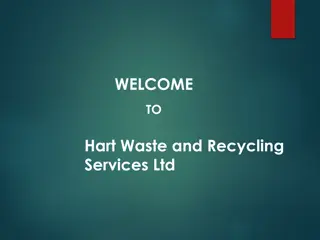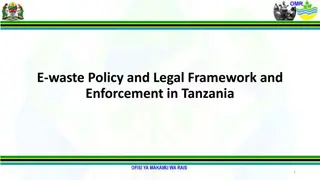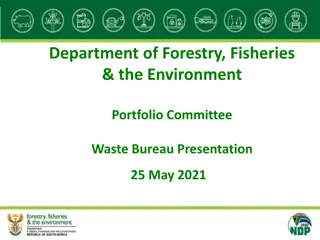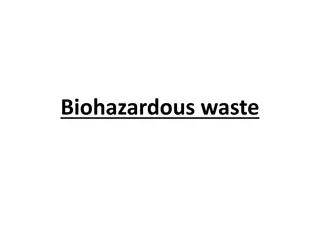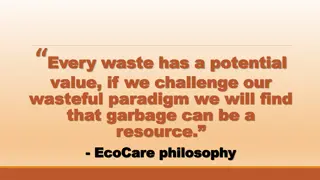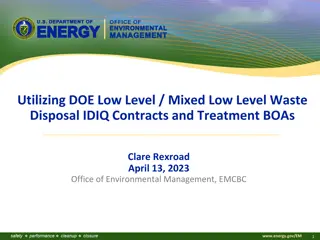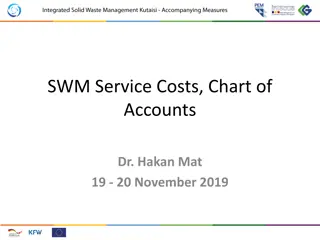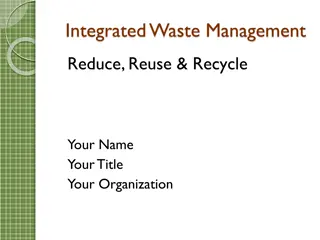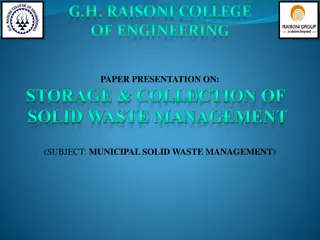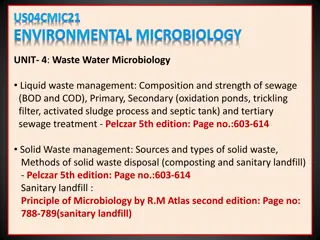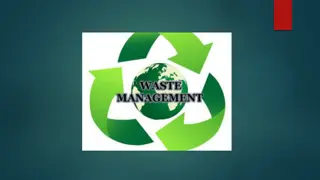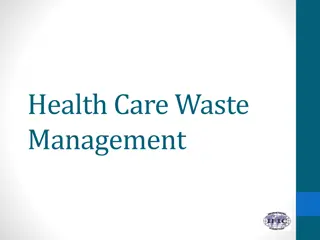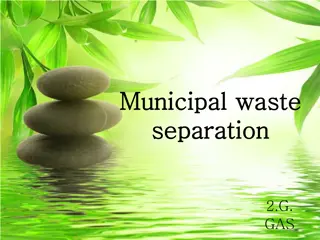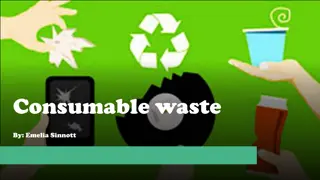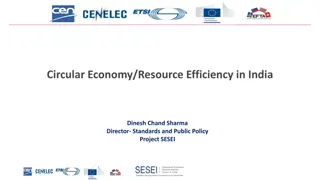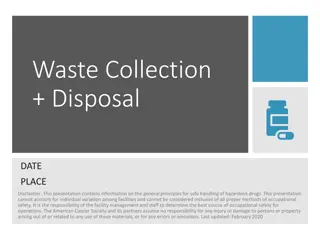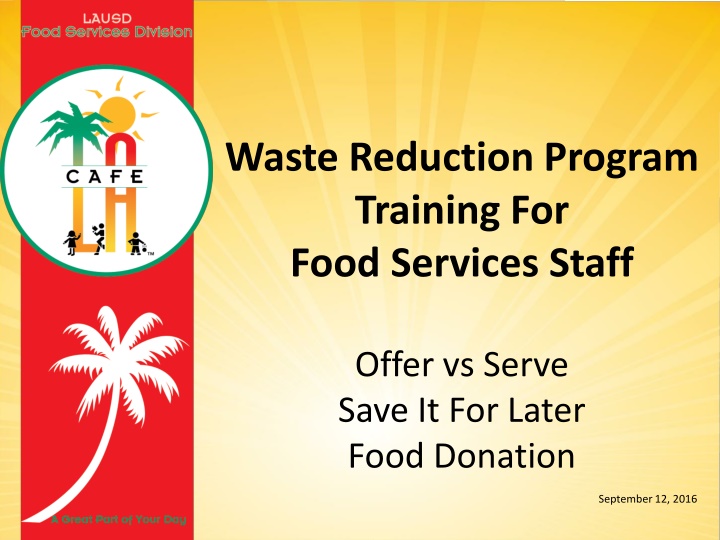
Effective Waste Reduction Strategies for Food Services Staff
This training program focuses on a Waste Reduction Initiative to combat food waste by implementing programs such as Offer vs. Serve, Save It For Later, and Food Donation. Staff are trained on how to reduce waste through proper selection and handling of food items. The program includes guidelines for breakfast selections, save-for-later options, morning announcements, and guidelines for the Breakfast in Classroom (BIC) program. By following these strategies, staff can not only minimize food waste but also contribute to potential donations to non-profit organizations.
Download Presentation

Please find below an Image/Link to download the presentation.
The content on the website is provided AS IS for your information and personal use only. It may not be sold, licensed, or shared on other websites without obtaining consent from the author. If you encounter any issues during the download, it is possible that the publisher has removed the file from their server.
You are allowed to download the files provided on this website for personal or commercial use, subject to the condition that they are used lawfully. All files are the property of their respective owners.
The content on the website is provided AS IS for your information and personal use only. It may not be sold, licensed, or shared on other websites without obtaining consent from the author.
E N D
Presentation Transcript
Waste Reduction Program Training For Food Services Staff Offer vs Serve Save It For Later Food Donation September 12, 2016
Improving The Program The Waste Reduction Initiative is a response to many concerns around Reducing Food Waste It Encompasses 3 Programs 1. Offer vs Serve at Breakfast, BIC and Lunch 2. Save It For Later (SIFL) 3. Food Donation Program
Breakfast Offer vs Serve Offer vs Serve (OVS) at BIC and Breakfast allows students to: Select at a minimum of 3 different d items, of which 1 must be fruit item Reduce waste
Save It For Later Breakfast Posters FS Managers will receive 1 Save it For Later poster for each classroom. The blank area of the poster is where the monthly menu should be posted Monthly menus will be delivered to classrooms at the start of every month
OVS and Save It For Later Breakfast Posters Students at a minimum must select 3 different starred items, at least 1 of which must be a Fruit Food items marked with an S may be saved for later if selected by students
PA Announcements Principals are asked to inform and encourage to: Make daily morning and afternoon PA announcements Scripted options are available in the SIFL toolkit Examples: Morning Announcement Good morning (insert school name or mascot), todays Save It for Later breakfast items are the Cheerios and the fresh apple. You can save these items to eat later in the day or during recess. Afternoon Announcement Hello Superstars! The new cafeteria menu features stars next to each menu item. Students are required to choose at least a 3 different starred items; one of those stars must be a fruit. Choose your superstar meal!
BIC Reminders Successful BIC Program Criteria The pre-selection of meals and placing them on desks is not allowed Check marks next to student s names on the roster indicate that a reimbursable meal (a minimum of 3 different items of which 1 is a fruit)was selected A dash mark indicates a student is absent/not participating. All items not selected by students must remain in the BIC Bag and be returned to the cafeteria. This is a critical point for reducing waste and allows for potential donations to non-profit organizations All items left on the sharing table after breakfast meal service must be discarded and not saved or returned to cafeteria.
Lunch Offer vs Serve Offer vs Serve (OVS) at lunch allows students to: Choose from 5 components offered Fruit Vegetables Fruit, Vegetables, Grains, Meat/Meat Alternate, Milk M/MA 3 full components must be selected Grain 1 component must be a fruit or vegetable Milk
Lunch Save It For Later Similar to breakfast, students will have the option of saving select items on the lunch menu. Food items marked with an S may be saved for later if selected by students as a part of their reimbursable meal.
Lunch Reminders Successful Lunch Program Criteria Pre-selecting meals for students is notallowed A reimbursable meal (minimum of 3 components of which 1 is a fruit or vegetable) is selected Encourage students to take only what is required for a reimbursable meal, if the other items are not going to be eaten. This will reduce waste Unopened items may be placed on the sharing table for those students who wish to have extras All items prepared in the cafeteria but not served to students may be donated to non-profit organizations provided they can not be used later.
Sharing Table 2 Implementation Steps in Setting Up the Sharing Tables: 1. Designate a Breakfast sharing table in classrooms or eating area (for Grab-N-Go sites) 2. Setting up a Lunch sharing table in the eating area Items already selected by students to meet the reimbursable meal requirements may be placed here for others wishing to have seconds Items on the sharing tables may be selected by others students to eat at a later time on campus NOTE: All items left on the sharing table after breakfast meal service must be discarded and not saved or returned to cafeteria.
Q & A Some Commonly Asked Questions Q: With multiple fruits and/or vegetables listed on the menu, how many can students take? A: Students must select at least 1 fruit or vegetable or they may select as many as 1 of each fruit and/or vegetable offered on the menu. Q: What do I do if there are items remaining on the sharing table in my classroom or in the outside eating area? A: The items will need to be discarded. They may not be given to others or donated. Q:How long can students keep item that are indicated with an S ? A: To ensure safety, it is recommended that all items other than whole fruit be consumed within two hours after service. Q: Who do I notify if I have concerns? A: Please contact your Cafeteria Manager or Area Food Services Supervisor. Visit our website at http://lausd.schoolwires.net/Page/1072 for a full list of Questions and Answers on the Waste Reduction/SIFL Programs.
LAUSD Food Donation Program The Healthy Students, Healthy Families, and Healthy Communities Resolution passed April 12, 2011 Introduced by Ex-Board Vice President Dr. Richard Vladovic, and cosponsored by other Board Members a) Allows the District to donate excess food that meets federal regulations, to needy families and children (through Non-Profit Organizations). a) The donations will be limited to packaged food items that have not been served to children as a part of the District s school meals program. To setup a new food donation process at your school: a) Let your Cafeteria Manager know that you are interested in beginning the process b) Utilize the agencies already approved on the Caf LA Website at http://achieve.lausd.net/FoodDonation OR c) Contact the agency of your choice and direct them to Food Services for information, paperwork and approval procedures
QUESTIONS? Your local Food Services Team is available to assist you with implementing the Waste Reduction Program

